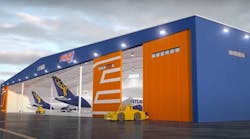Jan. 20--Under a mandate from the Federal Aviation Administration (FAA), Boeing's new 747-8 Intercontinental passenger jet will not be allowed to carry fuel in its tail until engineers can come up with a fix for a potential wing-vibration problem, Boeing said Thursday.
Boeing spokesman Jim Proulx said engineers are working toward designing, certifying and implementing a fix to the vibration issue sometime in 2013.
Until then, a section of fuel line will be removed to prevent fuel flowing back to the tank inside the horizontal stabilizer -- the small wings on either side of the tail.
This restriction will cut fuel capacity by about 3,300 gallons and reduce the range of the jet by 300 to 400 miles, Proulx said.
The big jet's total fuel capacity, including the tail tank, is advertised at 63,055 gallons, giving it a range of 9,200 miles while carrying 467 passengers.
"This is something we are working to rectify," Proulx said. "It isn't something that will keep the plane from going into service."
The first delivery of the 747-8 passenger model is expected next month, going to an unidentified VIP customer, believed to be the royal family of Kuwait. German carrier Lufthansa will take the second jet, probably in March.
Proulx said five of the jets have already rolled out without the required block to the tanks in the tail. Those jets will have to be modified by removing the section of fuel line, work that can be accomplished over three shifts, he said.
Subsequent airplanes will have the tail tank blocked inside the factory during assembly.
Boeing first discovered the problem last summer, according to a person with knowledge of the issue.
Engineering computer models were run to simulate the failure of a specific wing mounting strut, one of several redundant components that hold the outboard engines on the wings. For safety reasons, such a potential failure must be proved not to threaten flight safety if it occurs.
The computer analysis revealed that if that engine mounting strut were to fail, then extra weight at the rear of the aircraft from fuel in the tail would cause wing flutter.
Flutter is a phenomenon whereby structural vibrations enter a feedback cycle that enhances the shaking and can cause serious damage.
Proulx said this specific engine mounting strut has never actually failed on any previous 747 model nor in flight tests of the 747-8.
"This is something we found during analysis, not test," he said.
The problem does not affect the 747-8 freighter, which doesn't have a fuel tank in the tail.
Nor does it affect the 747-400 passenger jets currently flying.
Flutter is unpredictable and can become an issue in any physical structure when relatively minor changes are introduced into a design. The 747-8 has a 60-inch fuselage extension behind the wing compared with the 747-400. That's enough to introduce potential flutter issues.
The person familiar with the details, who spoke on condition of anonymity, said eliminating the flutter problem will mean redesigning the mounting strut.
In the meantime, Boeing will deliver the big jets with the fuel tank inside the tail deactivated and physically separated from the main fuel tanks in the wings.
Boeing had initially hoped just to cap the fuel lines that lead to the tail tank. To avoid nuisance-warning messages, it decided not to turn off the power to various electrical systems inside the tank, such as the fuel pumps and the fuel-gauge system.
The person with knowledge of the details said guards will be placed over switches controlling the tail tank fuel pumps to ensure mechanics don't accidentally switch them on during routine maintenance.
However, the FAA expressed concern that if Boeing merely sealed off the fuel lines, the seals could leak at some stage. If even a little fuel leaked into the tail tank, the vapor would then create a potential ignition hazard from the electrical components.
The FAA therefore mandated as a condition of certification that the tail tank had to be physically separated from the main tanks. Boeing agreed, and in December the FAA duly certified the airplane with the tail tank separated.
"It's not a showstopper;" said the person familiar with the issue, "only if you needed the extra range."
News of the problem was first reported Thursday by Flightblogger on the website of Flight International magazine.
Flight quoted a Lufthansa spokesperson saying that the fuel restriction won't restrict the aircraft's deployment on its initial routes.
"For our mission profile, it's not a problem at the moment, " Lufthansa told Flight.
The extra range would be needed only to fly nonstop on ultralong routes, such as from New York to Auckland, New Zealand.
Boeing has just 36 orders for the 250-foot-long passenger plane. Lufthansa has ordered 20, Korean Air five, and Arik Air of Nigeria two.
The remaining nine orders are for unidentified VIP customers buying their own giant personal jets. At least five of those are for Middle Eastern customers in Kuwait, Qatar and the United Arab Emirates.
Dominic Gates: 206-464-2963 or [email protected]
Copyright 2012 - The Seattle Times


